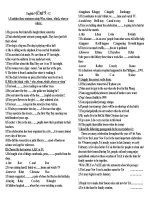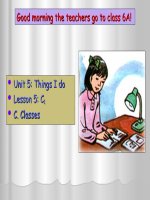Unit 9
Bạn đang xem bản rút gọn của tài liệu. Xem và tải ngay bản đầy đủ của tài liệu tại đây (154.51 KB, 18 trang )
<span class='text_page_counter'>(1)</span><div class='page_container' data-page=1>
Date of preparing: 02/ 01/ 2010
Date of teaching:
Class: Attendane:
Period 54th
<b>Unit 9: THE POST OFFICE</b>
<b>Lesson 2: SPEAKING</b>
<b>I. objectives:</b>
<i><b>1. Aims:</b></i> By the end of the lesson, Ss will be able to
- Use appropriate language to make dialogues in formal business situations.
<i><b>2. Knowledge: </b></i>
- Grammar: Wh-questions
- Lexical items: Words related to the Post office services.
<i><b>3. Skills: </b></i>
- Main skill: Speaking.
- Sub-skills: Reading, listening, writing.
<b>II. Methods: Integrated, mainly communicative.</b>
<b>III. Teaching aids: Textbook, </b>
<b>IV. Anticipated problems:</b>
<i>Ss may transfer the Vietnamese speaking rules when making requests in </i>
<i>English, which could cause communication difficulty. So T should raise </i>
<i>their awareness of linguistic and socio- cultural differences between English</i>
<i>and Vietnamese speakers in the way they make requests.</i>
<b>V. Procedure</b>
1. Greeting and checking Ss’ attendance.
2. Checking: Ask Ss to write the new words on board.
3. New lesson:
<i><b>Teacher’s activities</b></i> <i><b>Students’ activities</b></i>
<b>Warm- up</b>
<i><b>Brainstorming:</b></i>
- T write the words Post office
services on board and asks Ss to
brainstorm all the words related to
the topic.
- T gets the answers from Ss.
- Observe T’s words and then
brainstorm the words related to the
topic.
- Read out the answers.
<i><b>Suggested answers</b></i>
</div>
<span class='text_page_counter'>(2)</span><div class='page_container' data-page=2>
<i><b>Task 1: </b></i>
- T leads Ss to the topic of the lesson
by getting them to look at the picture
on page 103 and asks some questions
like “ What can you see in the
picture? Where do you think these
people are? Who is the man? Who is
the woman? What might the man
want to do? Etc” .
- Then T introduces the task to Ss:
Act out the dialogue and then answer
the question.
- T reads the dialogue once for Ss
first.
- Then T gets Ss to practice reading
the dialogue in pairs.
- T goes around to observe.
- T calls on some pairs to practice the
dialogue in front of the class.
- After getting SS practice in front of
the class, T gets some Ss to answer
the question “ What service is the
customer taking in the dialogue?”.
- T gives Ss some structures to
express requests.
<i><b>Task 2:</b></i>
- T introduces Task 2 to Ss: Make
conservation from the suggestions.
- T explains the task and elicits some
useful structures asking about fee,
- Look at the pictures on page 103
and answers T’s questions.
Study Task 1: Act out the dialogue
and then answer the question.
- Listen to the dialogue.
- Practice reading the dialogue in
pairs.
- Practice the dialogue in front of the
class.
- Answer the question in front of the
class.
<i><b>Answer:</b></i>
<i>The service the customer is using is </i>
<i>the fax service.</i>
- Study stuctures of giving requests.
<i>+ Could you help me to………?</i>
<i>+ Would you please……….? </i>
<i>+ Would you mind…………?</i>
<i>+ Can you …………please?</i>
- Study Task 2 and structures.
<i>+ What is the installation fee/ </i>
<i>monthly fee?</i>
<i>+ What is your address?</i>
</div>
<span class='text_page_counter'>(3)</span><div class='page_container' data-page=3>
address, etc.
- Then T puts Ss in pairs and gets
them to write the dialogue together
based on the information given in the
task and then practice reading the
dialogue.
- T goes around to observe and
provide help if necessary.
- T calls on some pairs to act out the
dialogue in front of the class.
- T listens to Ss’ practice and then
gives comments.
- T introduces sample dialogue to Ss.
<i><b>Task 3</b></i>:
- T introduces the situations to Ss
and then asks them to work in pairs
again and make dialogue of two
situations.
<i>place?</i>
- Work in pairs and write the
dialogue based on the information
given in the task, and then practice
reading it.
- Act out the dialogue in front of the
class.
- Listen to Ss’ comments.
- Study sample dialogue and practice.
<i><b>Sample dialogue</b></i>:
<i>A: Good morning. Can I help you?</i>
<i>B: Yes. I want to have a telephone </i>
<i>line installed at home.</i>
<i>A: Ok. Where do you live?</i>
<i>B: I live at 67 Ngoc Ha Street. When </i>
<i>can you install it?</i>
<i>A: We can install it one week after </i>
<i>you have registered.</i>
<i>B: Can you come on Friday?</i>
<i>A: Yes, that’s fine. Do you have a </i>
<i>telephone yet?</i>
<i>B: Yes. I have a telephone already. </i>
<i>How much is the installation fee and </i>
<i>monthly fee?</i>
<i>A: The installation fee is 1 million </i>
<i>dong and the monthly fee is 27 </i>
<i>thousand dong. Can you fill in the </i>
<i>form?</i>
- Study Task 3.
- Work in pairs and make dialogue,
using given situations.
</div>
<span class='text_page_counter'>(4)</span><div class='page_container' data-page=4>
- T can make a dialogue with a
student in front of the class as model.
- T goes around and gives help if
necessary.
- T calls on some pairs to present the
dialogue in front of the class.
- T comments on Ss’ dialogue.
- T introduces sample dialogues if Ss
find difficult in making dialogue
themselves.
- T gets Ss to practice the sample
dialogues and add more information
if they can.
- T listens to Ss’ practice and gives
comments on pronunciation and
intonation.
- Present the dialogue in front of the
class.
- Listen to T’s comments.
- Study T’s sample dialogues.
<i><b>A:</b> Good morning. Can I help you? </i>
<i><b>B:</b> Yes. I would like to subscribe to</i>
<i>Lao Dong daily newspaper. </i>
<i><b>A:</b> Yes, how long would you like to</i>
<i>get the newspaper? </i>
<i><b>B:</b> For a year please. </i>
<i><b>A:</b> Where would you like to get the</i>
<i>newspaper?</i>
<i><b>B:</b> At home. I live at 67 Ngoc Ha</i>
<i>street. </i>
<i><b>A:</b> ok. 67 Ngoc Ha street.</i>
<i><b>B: </b>Oh, can I get the newspaper every</i>
<i>morning before 6.30?</i>
<i><b>A:</b> Before 6.30? Well, it might be a</i>
<i>little bit too early. How about before</i>
<i>7.30? </i>
<i><b>B:</b> OK. That’s fine. Thank you! </i>
<i><b>A:</b> All right. Could you fill in this</i>
<i>form please? </i>
<i><b>Dialogue2 :</b></i>
<i>A: Good morning. What can I do for</i>
<i>you? </i>
<i>B: Yes. I would like to send a</i>
<i>greetings card and some flowers to</i>
<i>my friend on her birthday. </i>
<i>A: Right. When is your friend’s</i>
<i>birthday? </i>
<i>B: It’s May 16th<sub>. </sub></i>
<i>A: What kind of flowers would you</i>
<i>like to send? </i>
<i>B: Roses. A bunch of red roses</i>
<i>please. </i>
</div>
<span class='text_page_counter'>(5)</span><div class='page_container' data-page=5>
<i>16th<sub> or a day before? </sub></i>
<i>B: On May 16th<sub>. It’s best to deliver in</sub></i>
<i>the early morning.</i>
<i>A: OK. I make a note for that. Could</i>
<i>you please fill in this form? And</i>
<i>don’t forget to write the recipient’s</i>
<i>address clearly. </i>
4-Consolidation: - Summarize the main points of the lesson they have leanrt.
5-Homework : - Do exercise in workbook and prepare for Listening
lesson.
</div>
<span class='text_page_counter'>(6)</span><div class='page_container' data-page=6>
Class: Attendane:
Period 55th
<b>Unit 9: THE POST OFFICE</b>
<b>Lesson 3: LISTENING</b>
<b>I. objectives:</b>
<i><b>1. Aims:</b></i> By the end of the lesson, Ss will be able to
- Develop such listening micro- skill as listening for specific and detailed
information.
- Summary the information they have listened.
<i><b>2. Knowledge</b></i>:
- Lexical items: Words related to the development of Vietnam’s telephone
system.
<i><b>3. Skills: </b></i>
- Main skill: Listening
- Sub-skills: Reading, Speaking, writing.
<b>II. Methods: Integrated, mainly communicative.</b>
<b>III. Teaching aids: Textbook, tape and cassette.</b>
<b>IV. Anticipated problems:</b>
- The topic can be challenging for Ss, so T should prepare them enough for
listening tasks.
<b>V. Procedure</b>
1. Greeting and checking Ss’ attendance.
2. Checking: Ask Ss to write the new words on board.
3. New lesson:
<i><b>Teacher’s activities</b></i> <i><b>Students’ activities</b></i>
<b>Warm-up</b>
- T divides the class into small
groups and asks the groups to
generate as many words related to
telephone as possible in 5 minutes.
The group with the more points will
be the winner.
<i><b>BEFORE YOU LISTEN</b></i>
- Work in groups and generate the
words related to telephone in 5
minutes.
<i><b>Suggested answers</b></i>:
Dial, cell phone, network, digit, fixed
telephone, subcriber, fee, mail,
telephone bill, etc.
</div>
<span class='text_page_counter'>(7)</span><div class='page_container' data-page=7>
- T gets Ss to discuss the questions
on page105 in pairs.
- T calls on some Ss to answer the
questions in front of the class.
- T listens to Ss’ answers and gives
corrective feedback.
Pre-teaching vocabulary
- T gets Ss to study the words given
in the book.
- T plays the tape for Ss to listen to
the words and then plays the tape
again and asks Ss to repeat in chorus
several times.
- T explains the meaning of the
words for SS.
<b>WHILE YOU LISTEN</b>
- T introduces the topic of the
listening passage to Ss: You are
going to listen about the
development of Vietnam’s telephone
system over the past years. Then do
the tasks that follow.
in pairs.
- Answer the questions in front of the
class.
<i><b>Answer:</b></i>
<i>3. Advantages of a cellphone: </i>
<i>contact other people easily; be </i>
<i>reached at almost anytime, </i>
<i>anywhere; get important information</i>
<i>easily; feel close to family when </i>
<i>being away from home, etc.</i>
<i>Disadvantages: Do not have much </i>
<i>privacy; be irritated when sleeping </i>
<i>or meeting, etc.</i>
- Study the words in book.
- Listen to the tape and then repeat in
chorus.
- Study the meaning of the new
words:
<i>+ commune ( n ): x·</i>
<i>+ communal growth ( n) : sự phát </i>
<i>triển cộng đồng</i>
<i>+ digit subcriber ( n) : sè thuª bao</i>
<i>+ rural network ( n) : mạng lới nô.ng</i>
<i>thôn</i>
<i>+ capacity ( n): công suất, khả năng</i>
- Listen to Ts introduction of the
topic of the listening passage.
</div>
<span class='text_page_counter'>(8)</span><div class='page_container' data-page=8>
<i><b> TASK 1: </b></i>
- T gets Ss to study Task 1: read the
questions carefully and work out
what information they need to
concentrate on while listening by
underlining the key words.
- T gets Ss to read the options in each
question carefully and underline the
words that make them different.
- T encourages Ss to guess the
answers in each question.
- T plays the tape once or twice for
Ss to listen and then do the task.
- T asks Ss to compare the answers
with a partner.
- T gets the answers from Ss.
- T checks the answers with the
whole class.
- T plays the tape again for Ss to
check their answers. T pauses at the
answers for Ss to catch.
<i><b>TASK 2: </b></i>
- T gets Ss to study Task 2: Listen
again and then answer the questions.
- T asks Ss to read the questions and
underline the key words.
- T gets Ss to listen to the tape again
and answer the questions.
- T calls on some Ss to write the
answer on the board.
- T checks the answers in front of the
class.
carefully and underline the key
words.
- Read the options of each question
carefully.
- Guess the answer of each question.
- Listen to the tape and do the task.
- Compare the answers with a
partner.
- Read out the answers in front of the
class.
- Observe T’s cheching.
- Listen again and check the answers.
<i><b>Answers:</b></i>
<i>1. B</i>
<i>2. D</i>
<i>3. C</i>
<i>4. D</i>
<i>5. C</i>
- Study Task 2 carefully.
- Read the questions and underline
key words.
- Listen to the tape again and then
answer the questions.
- Write the answers on the board.
- Observe T’s checking.
- Listen again and check the answers.
</div>
<span class='text_page_counter'>(9)</span><div class='page_container' data-page=9>
- T plays the tape again for Ss to
check the answers.
<b>AFTER YOU LISTEN</b>
- T devides the class into small
groups of 3 or 4 and gets them to
summarise the listening passage
based on their notes and given cues
in the book.
- T goes around to observe and offer
help if necessary.
- After checking that all the groups
have finished, T calls on the
representative of each group to
present the summary in front of the
class.
- T listens andd takes notes errors
and then gives corrective feedback.
<i>1. China has the best growth in</i>
<i>number of telephone subcribers.</i>
<i>2. In the early 1990s, there were only</i>
<i>140.000 telephones in VN. </i>
<i>3. In the 1996, there were changed</i>
<i>from six to seven digits in Hanoi</i>
<i>and HCM City as well as five to</i>
<i>six digits in other Provinces. </i>
<i>4. In 2001.</i>
<i>5. There are 6.014 communal post</i>
<i>offices in VN . </i>
- Work in groups of 3 or 4 and
summarize the listening passage
based on their notes and given
cues.
- Present the summary in front of the
class.
- Listen to T’s feedback.
4. Consolidation: Summarise the main points of the lesson.
5. Homework: Ask Ss to learn the new words by heart and prepare for the
writing lesson.
</div>
<span class='text_page_counter'>(10)</span><div class='page_container' data-page=10>
Class: Attendane:
Period 56th
<b>Unit 9: THE POST OFFICE</b>
<b>Lesson 4: WRITING</b>
<b>I. Objectives:</b>
<i><b>1. Aims</b></i>: By the end of the lesson, Ss will be able to
- Write a formal letter to express satisfaction or dissatisfaction.
<i><b>2. Knowledge</b></i>:
- Lexical items: Words related to Post office service.
<i><b>3. Skills</b></i>:
- Main skill: Writing
- Sub-skills: Reading, Speaking, Listening
<b>II. Methods: Integrated, mainly communicative.</b>
<b>III. Teaching aids: Textbook, sample writing.</b>
<b>IV. Anticipated problems:</b>
Ss may not have enough language to write the letter, so T should be ready to
help them.
<b>V. Procedure</b>
1. Greeting and checking Ss’ attendance.
2. Checking: Ask Ss to write the new words on board.
3. New lesson:
<i><b>Teacher’s activities</b></i> <i><b>Students’ activities</b></i>
<b>Warm-up</b>
- T gives Ss some adjectives gets Ss
to work in groups 3 or 4 and then
choose the adjectives which make
people satisfied. The group which
finishes first with the most correct
answers will be the winner.
<i><b>Adjectives:</b></i>
<i>Polite , rude , cold , helpful ,</i>
<i>spacious , crumpled , large , small ,</i>
<i>good , bad, reasonable , expensive ,</i>
<i>cheap , arrogant , punctual , reliable</i>
.
- Then T introduces the topic of the
lesson to Ss.
- Work in groups and choose the
adjectives which make people
satisfied.
<b>Key:</b>
</div>
<span class='text_page_counter'>(11)</span><div class='page_container' data-page=11>
<i><b>TASK 1</b></i>
- T explains the task for Ss and asks
them to read through it.
- T explains new words for Ss if
necessary.
Note: T can remind Ss that they can
talk about any post office that they
know if they do not like to talk about
Thanh Ba post office.
- Then T asks Ss to work in pairs and
talk about things that they like or
they dislike about the services at
Thanh Ba Post Office or a post office
they know.
- T goes around and offers help if
necessary.
- After few minutes T elicits answers
from Ss and writes the good ideas on
the blackboard.
<i><b>TASK 2</b></i>
- T introduces Task 2 to Ss: Write a
letter to the director of Thanh Ba
Post office describing the quality of
its services, using the ideas in Task
1.
- T draws Ss’ attention to the fact
that when evaluating something
people normally say about good
things before they say about negative
things and people may also want to
give suggestions to improve things
they find not good enough.
- T helps Ss to work out the structure
of the letter they are going to write.
- Listen to T’s explanation of the task
and read through the task.
- Study new words.
- Listen to T’s remind.
- Work in pairs and then talk about
things that they like or do not like
about the services at post office.
- Present the answers in front of the
class.
- Listen to T’s introduction of Task
2.
- Listen to T’s remind of giving
evaluation to something.
- Study the structure of the letter.
<i>Opening</i> <i>- Introduce who you </i>
<i>are.</i>
<i>- Say the purpose of </i>
<i>your letter.</i>
<i>First </i>
<i>paragrap</i>
<i>h</i>
</div>
<span class='text_page_counter'>(12)</span><div class='page_container' data-page=12>
- T reviews the structures of giving
suggestions for Ss.
- T divides the class into 3 groups
and asks one group writes about
satisfaction of the services, one
group writes about dissatisfaction
and the last group writes about both
satisfaction and dissatisfaction.
- T goes around to observe and give
help if necessary.
- After 12 minutes, T gets the
writings from 3 groups and gets
comments from Ss for each writing.
- T gives final comments.
- T introduces sample letter.
<i>Second </i>
<i>paragrap</i>
<i>h</i>
<i>- Say about what you </i>
<i>do not like about the </i>
<i>service.</i>
<i>- Make suggestions if </i>
<i>possible.</i>
<i>Closing</i> <i>- Thank the recipient </i>
<i>for the time and </i>
<i>attention.</i>
<i>- Good-bye.</i>
- Study the structures of giving
suggestions.
<i>+ It would be a good idea </i>
<i>to…………. , if I could make a </i>
<i>suggestion</i>
<i>+ If I could make a suggestion, that </i>
<i>would be about………</i>
<i>+ I would suggest………</i>
- Work in 3 groups to write the letter.
- Give out the answers and then
comment.
- Listen to T’s comments.
- Study sample letter.
Sample letter:
</div>
<span class='text_page_counter'>(13)</span><div class='page_container' data-page=13>
Mr. Vu Nguyen Hung
Director, Thanh Ba Post Office
2 Tran Hung Dao St.
Dear Mr. Vu Nguyen Hung,
My name is Nguyen Thanh Mai. I am a regular customer of Thanh Ba Post
Office. I am writing in reference to your invitation for comments about the
services offered at your post office and suggestions for improving them.
I think generally, your services are very good. For example, I especially like
the Flower Telegram Service. It is much cheaper than many florists’ that I
know. I also like the Express Money Transfer service. It is speedy and
effective. And I like the Press Distribution service. The delivery is always
punctual and I never lose any newspapers. I highly appreciate the fact that
your staff are helpful and courteous.
If I could make a suggestion, however, that would probably be about your
business hours. I think you close quite early. I thought it may be a good idea
to keep the post office open until 10 or 10:30 pm.
Thank you very much for your time and attention.
Kind regards,
Nguyen Thanh Mai
4. Consolidation: Summarise the main points of the lesson.
5. Homework: Ask Ss to rewrite the letter at home.
Ask Ss to prepare for the Language Focus Lesson.
Date of preparing: 08/01/2010
Date of teaching:
</div>
<span class='text_page_counter'>(14)</span><div class='page_container' data-page=14>
Period 57th
<b>Unit 9: THE POST OFFICE</b>
<b>Lesson 5: LANGUAGE FOCUS</b>
<b>I. Objectives:</b>
<i><b>1. Aims</b></i>: By the end of the lesson, Ss will be able to
- Distiguish the sounds / sp /, / st /, and / sk /.
- Pronounce the words and sentences containing these sounds correctly.
- Distinguish the use of defining and non-defining relative clauses and use
these two structures correctly and appropriately.
<i><b>2. Knowledge</b></i>:
- Grammar: Defining and non-defining relative clauses.
- Lexical items: Words related to the sounds / sp /, / st /, and / sk /.
<i><b>3. Skills</b></i>: Reading, Speaking, Listening, Writing.
<b>II. Methods: Integrated, mainly communicative.</b>
III. Teaching aids: Textbook, tape and cassette.
<b>IV. Anticipated problems:</b>
Ss may have difficulty in distinguish defining and non-defining relative
clause, so T should be ready to help them.
<b>V. Procedure</b>
1. Greeting and checking Ss’ attendance.
2. Checking:
3. New lesson:
<i><b>Teacher’s activities</b></i> <i><b>Students’ activities</b></i>
<b>PRONUNCIATION</b>
<b>Distinguish the sounds</b>
- T models the three consonant
clusters / sp /, / st /, / sk / for Ss
several times.
- T plays the tape once for Ss to
listen to the words containing these
sounds first, and then plays again and
asks Ss to repeat after the tape.
- T gets Ss to read the words in three
columns aloud in chorus several
times.
<b>Practice sentences containing the </b>
<b>target sounds</b>
- See T’s model.
- Listen to the words containing the
sounds and then repeat after the tape.
- Practice reading the words in
chorus several times.
</div>
<span class='text_page_counter'>(15)</span><div class='page_container' data-page=15>
- T plays the tape of the dialogue for
Ss to listen. Then T asks Ss to
practice reading the dialogue an
pairs.
- T calls on some pairs to read the
dialogue in front of the class.
- T listens and then correct
pronunciation mistakes.
<b>GRAMMAR</b>
<i><b>EXERCISE 1</b></i>
- T introduces the requirement of the
exercise to Ss: Explain the given
words using the phrases from the
box.
- T gets Ss to read the example and
analyze the form of the relative
clause occurring in it.
- T gets Ss to work out the meaning,
the use and the form of defining
relative clause.
- T listens to Ss’ answers and correct
or add more information if
necessary.
- T gets Ss to complete the exercise 1
in the same way as the example. T
explains the new words before
getting Ss to do the exercise.
the target language and then practice
reading it in pairs.
- Practice the dialogue in front of the
class.
- Listen to T’s correction.
- Study Exercise 1: Explain the given
words using the phrases from the
box.
- Read the example and then analyse
it.
- Work out the meaning, the use and
the form of defining relative clause.
<i>+ Meaning and use: Defining </i>
<i>relative clauses are used in order to </i>
<i>give important information about a </i>
<i>person or an object. This </i>
<i>information helps to distinguish </i>
<i>him/her/it from others.</i>
<i>+ Form: There is no comma between</i>
<i>main clause and the relative clause.</i>
<i>The relative clause can start with </i>
<i>any pronouns like Who, Whom, </i>
<i>Whose, Which, Where, What, That.</i>
- Study new words and then do
Exercise 1.
<i>+ burglar (n): tªn trém</i>
<i>+ shoplifter (n): ngời ăn trộm đồ của</i>
<i>cửa hàng</i>
<i>+ tenant (n): ngêi thuª</i>
<i>+ coward (n): kẻ hèn nhát</i>
</div>
<span class='text_page_counter'>(16)</span><div class='page_container' data-page=16>
- T calls on some Ss to go to the
board to write the answers down.
- T checks the answers with the
whole class.
<i><b>EXERCISE 2</b></i>
- T gets Ss to review the use of Who,
Whom and Whose.
- T asks Ss to give some examples to
check that Ss all understand the
rules.
- T gets Ss to do the exercise
individually and then compare the
answers with a partner.
- T calls on some Ss to read out the
answers in front of the class.
- T checks the answers with the
whole class and gives corrective
feedback if necessary.
<i><b>EXERCISE 3</b></i>
answers down.
- See T’s checking.
<i><b>Answers:</b></i>
<i>1. A burglar is someone who breaks </i>
<i>into a house to steal things.</i>
<i>2. A customer is someone who buys </i>
<i>something from a shop.</i>
<i>3. A shoplifter is someone who steals</i>
<i>from a shop.</i>
<i>4. A coward is someone who is not </i>
<i>brave.</i>
<i>5. A tenant is someone who pays rent</i>
<i>to live in a house or flat.</i>
- Review the use of Who, Whom and
Whose.
<i>+ Who is used to modify noun </i>
<i>subject. It refers to people.</i>
<i>+ Whom is used to modify noun </i>
<i>object. It refers to people.</i>
<i>+ Whose is used to express </i>
<i>possessive.</i>
- Give examples.
- Do the exercise individually and
then compare the answers with a
partner.
- Read out the answers in front of the
class.
- See T’s checking.
<i><b>Answers:</b></i>
<i>1. who</i>
<i>2. whose</i>
<i>3. whom</i>
<i>4. whose</i>
5. whom
</div>
<span class='text_page_counter'>(17)</span><div class='page_container' data-page=17>
- T gets Ss to distinguish the
difference between “ that” and “
Which”.
- T gets Ss to do Exercise 3 and then
compare then compare the answers
with a partner.
- T gets the answers from Ss.
EXERCISE 4
- T gets Ss to read the example and
analyze the form of the relative
clause occurring in it.
- T asks Ss to work out the meaning,
the use and the form of non-defining
relative clause based on the example.
- T gets Ss to do exercise 4
individually and then compare the
answers with a partner,
- T gets the answers from Ss.
- T checks Ss’ answers and gives
corrective feedback.
+ Which is used for objects.
+ That is used for both objects and
people.
- Do the exercise and then compare
the answers with a partner.
- Read the answers out.
Answers:
1. The man who answered the phone
told me you were away.
2. The girl who served us was very
impolite and impatient.
3. The building which was destroyed
in the fire has now been rebuilt.
4. The people who were arrested
have now been released.
5. The bus which goes to the airport
runs every half an hour.
- Read the example and then analyze
it.
- Work out the meaning, the use and
the form of defining relative clause.
+ Meaning and use: Non-defining
relative clauses are used to give
additional information about a person
or an object, not to distinguish
him/her/it.
+ Form: There is comma between 2
clause. It can be start with Who,
Whom, Which, etc, but not with
That.
- Do the exercise and then compare
with a partner.
- Give out the answers.
- See T’ checking.
Answers:
</div>
<span class='text_page_counter'>(18)</span><div class='page_container' data-page=18>
who is visiting us for a couple of
days.
3. You are moving to Manchester,
which is in the North-west.
4. I’ll be staying with Adrian, whose
brother is one of my closest friends.
5. John Bridge, who is one of my
oldest friends, has just gone to live in
Canada.
4. Consolidation: Summarise the main points of the lesson.
5. Homework: - Ask Ss to do exercises in workbook.
</div>
<!--links-->









